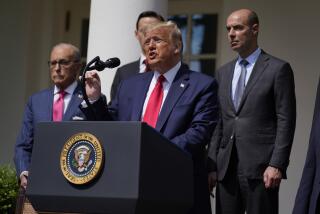Column: Trump’s Labor secretary comes out against giving workers a raise
Alexander Acosta may bear the title of U.S. Secretary of Labor, but you wouldn’t know it from the policies he has implemented as head of the one Cabinet-level department explicitly devoted to the welfare of American workers.
Since taking office in April 2017, Acosta has rolled back an Obama administration rule that would have doubled the maximum wage at which workers would be eligible for overtime pay and tied the ceiling to inflation in the future. He also scrapped an Obama-era rule that limited the ability of franchise owners to dodge liability for workplace and wage violations at their restaurants and stores.
This week, Acosta again showed his fealty to business lobbies instead of workers. In separate appearances before congressional committees Wednesday and Thursday, he expressed his opposition to increasing the federal minimum wage, which sits at $7.25 an hour.
If workers do not deserve [a raise] at this time, then when do they?
— Sen. Patty Murray (D-Wash.) to Labor Secretary Alexander Acosta
On both occasions, Acosta relied on a fatuous claim that raising the federal minimum would be tantamount to allowing the 29 states that have raised their minimums above the federal level to “impose their cost structures on the remaining 21 states.”
Acosta also misrepresented a Washington Post editorial on the topic by implying that it expressed opposition to the increase. Here’s its headline: “Congress should raise the minimum wage — the right way.” The editorial states that “the federal minimum wage does need an update.”
Acosta’s comments before the House Education and Labor Committee on Wednesday were chiefly aimed at a bill to raise the federal minimum to $15 over time. The measure was introduced by Rep. Robert C. Scott (D-Va.), the chairman of the House committee.
To place the federal minimum in perspective, it has been eaten away since 1968, when it peaked in inflation-adjusted terms at $10.15 (that is, in 2018 dollars). In other words, the federal minimum is lower today than it was 50 years ago. The rate has not been raised since 2009, when it was increased from $6.55.
Acosta is correct to observe that 21 states either have set their minimums at the federal level or have no state minimum wage, in which case they’re required to comply with the federal law.
Seven states and the district of Columbia have enacted increases aimed at reaching $15 an hour over time. In California, that goal will be reached Jan. 1, 2022. Others set longer transitions and lower goals — Michigan, for example, will reach a $12.05 minimum wage in 2030.
Some municipalities have set minimum wage rates that exceed their state levels. They include Seattle, which has implemented minimums of up to $16 for all but small employers, although the state of Washington will move to a $13.50 wage next Jan. 1, with inflation-indexed increases after that.
Those figures give the lie to Acosta’s assertion that the wage-increase states are “imposing” their cost structures on the holdouts. There’s little consistency among those states, and plenty of latitude to find a reasonable level somewhere between $15 and $7.25. As it happens, some Democrats have advocated a wage increase keyed to regional costs of living.
By any measure, today’s federal minimum wage is historically low. It’s now about one-third of the median full-time wage. That’s the lowest in the industrialized world, where the level tends to be 50% to 60% of the median wage, and close to a historical nadir for the U.S.
As the pro-labor Economic Policy Institute reports, the current minimum is a poverty level wage even for a two-person family. In 1968, it was enough to exceed the poverty level for a family of three. The U.S. economy has grown by nearly 24% in inflation-adjusted terms since 2009, while the federal minimum hasn’t budged. It should be obvious that a nation that could afford a minimum wage equivalent to $10.15 in 1968 can afford much more in 2019.
Despite these realities, Acosta simply slammed the door on any increase. “We do not support a change in the federal minimum wage at this time,” he told Scott’s committee.
At the Senate hearing the following day, Sen. Patty Murray (D-Wash.) tried to continue the conversation. Alluding to the long gap since the last increase, she asked, “If workers do not deserve [a raise] at this time, then when do they?” Acosta repeated his mantra about some states imposing their will on others, but didn’t answer the question.
Acosta long has been an ideological warrior against a minimum wage increase. In an interview with the Wall Street Journal in January, he maintained that a $15 minimum wage “will undermine this economy and job creation.” He didn’t offer an alternative proposal.
The evidence that a minimum wage increase would cost jobs is thin to nonexistent. The evidence from Seattle, where perhaps the most aggressive increase has been enacted, suggests that while the increase may have cost some jobs paying less than the minimum, it improved the lot for workers earning at the minimum or more. The most recent study from the University of Washington found that “the minimum wage increase from $9.47 to as much as $13 per hour raised earnings by an average of $8-$12 per week.” Is there something in those results that Acosta, the Labor secretary, doesn’t want to see?
Seattle, moreover, remains one of the fastest-growing labor markets in the country, another trend undermining the case of naysayers.
In general, economists have found no indications that minimum wage increases cost jobs. Some conjecture that steep increases might have that effect, but it’s hard to translate that to more modest raises implemented over a period of years.
Acosta’s adamant opposition to a minimum wage increase fits well with other policies with an anti-labor tilt at his department.
Consider the overtime rule. The current ceiling at which hourly workers become ineligible for time-and-a-half pay for overtime is $23,000. Obama’s rule raised that to $47,000, but Acosta’s will cover only workers earning up to $35,000 while eliminating the inflation indexing the Obama Labor Department implemented. The Obama rule would have aided 4 million more workers to the roll of eligible workers, Acosta’s only 1.2 million.
Soon after taking office, Acosta rescinded the Obama-era rule holding employers liable for workplace violations if they exercised “indirect control” over the workplaces. The so-called joint employer rule was a significant expansion of employer liability, for it extended their responsibility for workers hired by labor contractors, and subjected big franchise operations such as McDonald’s to potential liability for violations committed by their franchisees.
The joint employer rule also is under threat from the National Labor Relations Board, which first implemented it in 2015. But the board is now under Republican control, and is working on a revision.
Keep up to date with Michael Hiltzik. Follow @hiltzikm on Twitter, see his Facebook page, or email michael.hiltzik@latimes.com.
Return to Michael Hiltzik’s blog.
More to Read
Inside the business of entertainment
The Wide Shot brings you news, analysis and insights on everything from streaming wars to production — and what it all means for the future.
You may occasionally receive promotional content from the Los Angeles Times.











